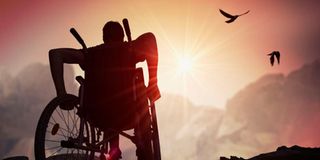Premium
Integrate the disabled in national GBV conversation

Persons with disabilities encounter barriers and challenges in all facets of life whether systemic, design or cultural.
The country has been recently engaged in conversations touching on gender-based violence (GBV), including femicide.
This resulted in President William Ruto appointing a taskforce, led by former Deputy Chief Justice Dr Nancy Baraza, to, among others, recommend measures to strengthen response to GBV, including femicide.
As the taskforce continues to collect views from the public, it is important to include the voices of persons with disabilities and the disability perspective on GBV.
The World Health Organization (WHO) estimates that one in three women globally encounters physical or sexual abuse – a figure that has stuck over the last decade. Notably, for young women aged 15–24, one in four of them who has been in a relationship will have experienced violence from an intimate partner by the time they reach mid-20s.
Sexual violence
At a national level, the 2022 Kenya National Demographics and Health Survey indicated that 34 per cent of women age 15 and above have experienced physical GBV, compared to 27 per cent of men. Similarly, 13 per cent of women at the same age bracket have experienced sexual violence, as compared to seven per cent of men. It is worth noting though, that the real situation of GBV among persons with disabilities is largely invisible in GBV-related statistics.
The paper—Gender-based violence among people with disabilities, is a neglected public health topic published on the journal Global Health Action—observed that persons with disabilities were twice (1.5 times) as likely to be GBV victims as compared to those without disabilities, while those with intellectual disabilities were four times likely to experience GBV – largely since they are viewed as ‘easy targets’ by the perpetrators.
The WHO adds that despite physical and sexual violence being the most encountered forms of GBV, as women with disabilities in particular age, the violence experienced often shifts from physical and/or sexual violence to psychological and emotional violence such as threats of desertion and various manipulative behaviours.
A policy brief by the United Disabled Persons of Kenya, an umbrella body of organisations of persons with disabilities, and the National Democratic Institute, a non-profit American organisation, noted that persons with disabilities are disproportionately affected by GBV because of ‘complex interplays of factors, including societal misconceptions, economic dependence, inaccessible support services and systemic barriers to justice’.
Persons with disabilities encounter barriers and challenges in all facets of life whether systemic, design or cultural. This makes them feel insignificant, ostracised by the community, with no one taking them seriously. They are, therefore, programmed to believe that their right is actually a privilege. This stigma occasions an environment that doesn’t encourage reporting of any violent incidents to the relevant authorities.
The current review process by the National GBV taskforce, therefore, presents a precious and historic opportunity to review the current interventions and judicial pathways to make them more accessible to persons with disabilities.
Gender-based abuses
Nobel Peace Prize Laureate Elie Wiesel said that “Silence encourages the tormentor, never the tormented.” This is relatable on GBV and disability matters.
Awareness needs to be raised among persons with disabilities in partnership with their organisations to educate them on their rights, and forms of gender-based abuses. This will enable persons with disabilities, especially those with intellectual disabilities to comprehend what qualifies as appropriate and inappropriate actions. Filling this information gap will not only be useful to protect persons with disabilities from becoming victims of GBV, but also prevent them from knowingly or unknowingly becoming perpetrators towards the people around them.
This information empowerment can then be complemented by GBV-related data collection disaggregated by gender, disability and other socio-economic indictors to inform targeted interventions. Also, to enhance sustainability, relevant players on this space can adopt a twin-track approach to strengthen and enhance the socio-economic independence of persons with disabilities.
This involves not only mainstreaming disability in GBV-related programmes, but also implementing economically uplifting programmes to free persons with disabilities from any forms of financial violence. This is equally very important to caregivers of persons with disabilities, who despite not being disabled themselves, bear the economic brunt of having to fully attend to their children hence economically inactive, and prone to abuse from their partners and the community around them.
With the number of persons with disabilities in Kenya on the rise due to various factors including road crashes, lifestyle diseases among others, the disability population is increasingly becoming the majority – ever-present in our families, workplaces and other social spaces. Therefore, including the voices of persons with disabilities in the GBV conversation will yield a society and a country that is safe for all to thrive.
Mr Hassan serves as a Commissioner of the Public Service Commission, and is also an author. He writes in his personal capacity. ([email protected]).

